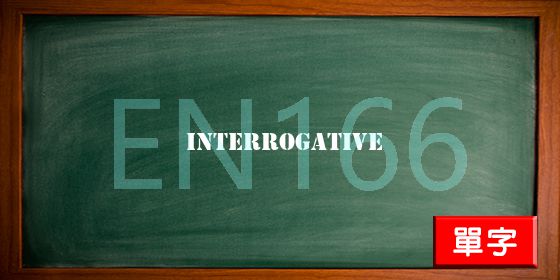interrogative adj.訊問性的,表示疑問的;質問的。 an inter...
adj. 訊問性的,表示疑問的;質問的。 an interrogative adverb 疑問副詞。 an interrogative pronoun 疑問代詞。 n. 疑問詞。 adv. -ly “interrogative adverb“ 中文翻譯: 疑問副詞“interrogative mode“ 中文翻譯: 詢問方式“interrogative pronoun“ 中文翻譯: 疑問代詞“interrogative sentance“ 中文翻譯: 疑問句“interrogative sentence“ 中文翻譯: 疑問句“interrogative substitute“ 中文翻譯: 疑問代替成分“interrogative transformation“ 中文翻譯: 疑問轉換“interrogative word“ 中文翻譯: 疑問詞“declarative interrogative four no trump“ 中文翻譯: 陳述一詢問性4nt“declarative-interrogative four no trump“ 中文翻譯: 陳述一詢問性4nt“questions with an interrogative pronoun“ 中文翻譯: 用疑問代詞的問句“in an interrogative tone manner etc“ 中文翻譯: 疑問的口吻“an interrogative look glance remark etc“ 中文翻譯: 疑問的神情“interrogativ“ 中文翻譯: 疑惑的; 疑問詞; 疑問的; 質問的“interrogational“ 中文翻譯: 審訊的“interrogation zone basics“ 中文翻譯: 偵測器的基本認識“interrogation winding“ 中文翻譯: 詢問繞組“interrogation valve“ 中文翻譯: 詢問閥
interrogator |
|
Emerged in the interrogative pronoun , the expression ways of ( dingzhen ) rhetoric and “ be listed in the order of number “ were commonly used ; most chapters rely mainly on four - word rhyme , and have the phenomenon of mixed use of rhyme such as - ( dong dong ) , ( yu hou ) , ( zhi zhi ) ( zhi zhl ) etc . some chapters are documents of xizhou dynasty displaying frequent use of modal particle ( zai ) and its function is variable ; the first pers “而”與“乃”的作用主要是作定語,它們在《逸周書》中的分布呈互補狀態,即用“而”之篇不用“乃” ,用“乃”各篇亦不用“而” ,這表明相關各篇的作者方言不同或所處時代不同。此外,第一人稱代詞“余”產生較早,甲骨文中己有, “予”則是戰國中期文獻中常用的。 |
|
Chapter : this part is concerned with the investigation on the characteristics of the sentence types in news titles . it focuses on the study of declarative sentences , interrogative sentences , imperative sentences and exclamatory sentences . structurally , these four sentence types have some characteristics as follows : the declarative 結語:首先對全文內容作了綜述,其后提出,對考察中發現的、而在文中沒有論述的如新聞標題的歧義結構、新聞內部體裁標題結構等問題有待于做進一步更深、更細的考察分析和討論。 |
|
In chinese broadcast advertisement , the declarative brand sentence is suited to give the audience the informations of the brand , so it dominates the brand sentences , while interrogative sentence , imperative sentence , exclamation sentence , can arouse an audience ' s attention , urge an audience to act , so they are also used fairly frequently 摘要廣播廣告中,陳述性品牌句適合給予聽眾品牌信息,處于絕對優勢,但疑問句、祈使句、感嘆句,能夠喚起聽眾注意,促使聽眾行動,因此出現的頻率也非常高。 |
|
Apart from being used as an auxiliary word of continuous movement in tangshan dialect , “ 著 “ can also be used as an auxiliary word of past tense , in which case it is attached to verbal phrases in the end of declarative sentence or interrogative sentence , indicating past tense 摘要“著”在唐山方言中,除了作表示持續的動態助詞外,還可以作表示過去時的時態助詞,它表示過去時態,主要用于陳述句和疑問句,通常用于句末,附著于動詞性詞語。 |
|
The men who stood planted in front of the notices kept spelling it out loudly ; others , in an interrogative tone , uttered it as they passed ; while the women , at once restless and smiling , repeated it softly with an air of surprise 男人們佇立在海報前,高聲拼讀著娜娜的名字另一些人經過那里時也用詢問的口氣把那名字讀一遍。而婦女們呢,個個心情焦急,臉上掛著微笑,用詫異的神態一遍又一遍地低聲讀著娜娜的名字。 |
|
Sometimes interrogative pronouns 誰 , 什么 , 哪 , 哪兒 and 怎么 are used to refer to anybody , anything or whatever way , emphasizing “ no exception “ . 都 / 也 are normally used after them 疑問代詞“誰、什么、哪、哪兒、怎么“可以在句中指代任何人、事物或方式,強調沒有例外。后邊常與“都“或“也“呼應。 |
|
The conjunction “ 還是 ” is used in an interrogative sentence to connect two or more alternative for the address to choose . such a question is known as alternative question 用連詞“還是”并列兩種以上情況,讓對方選擇其中一項回答,可以詢問句中不同成分。這種是選擇疑問句。 |
|
A yes / no question is made by adding the interrogative particle “ 嗎 ” at the end of a declarative sentence . the sentence pattern is : declaretive sentence + “ 嗎 ” 在陳述句的末尾加上表示疑問語氣的助詞“嗎” ,就構成了是非問句。句型是:陳述句+嗎? |
|
In information communication model interrogative mood must follow the pragmatic principle of “ from the speaker to the listener “ 摘要疑問語氣在信息交流模式上必須遵循“聽者說者”的語用原則,因此,主語“我”是有標記的。 |
|
We choose the interrogative words , syntax structure , question focus words and their first sememes as classification feature 該方法以問題的疑問詞、句法結構、疑問意向詞、疑問意向詞在知網中的首義原作為分類特征。 |
|
Indicates the continuation of an action or a state . it often occurs in an interrogative sentence or a sentence with an auxiliary verb 表示動作行為的繼續進行或狀態的繼續存在。常用于疑問句或有能愿動詞的句中。 |
|
Two same interrogative pronouns used in a sentence refer to the same person or subject , with the second one decided by the first 兩個相同的疑問代詞出現在同一句子中,指代相同的人或事物,表示前者決定后者。 |
|
Morrel then cast on the invalid an interrogative look as to the new favor which he designed to bestow on him 于是莫雷爾就朝那年輕女郎投過去一個征詢的目光,想知道現在又有什么新的恩典要賜予他。 |
|
This applies to all forms of sentence , including statements , imperative and interrogative forms 這一方法適用于所有句式,包括陳述句、祈使句和疑問句。 |
|
Restricted interrogative sentences are pragmatically presented as various untrue interrogative sentences 受限制疑問句在語用上表現為各種非真性問句。 |
|
On the biological evolution of the english language reflected by the changes of interrogatives 論英語疑問句變化折射的語言生物進化現象 |
|
Semantic and pragmatic classification of answers and interrogative statements in modern chinese 答語與現代漢語疑問句的語義語用分類 |
|
Psychological analysis and interrogative tactics during confession by crime suspects 犯罪嫌疑人臨近供認階段心理分析與訊問策略運用 |
|
There are three forms of the sentences affirmative , interrogative , and negative 句子有三種形式:肯定句、否定句和疑問句。 |

